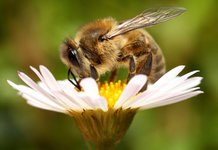
Undoubtedly the most responsible and troubled period for the beekeeper is wintering. However, in the spring, the trouble is no less, and the responsibility associated with preparing families for summer honey collection is even greater.

In all regions, the onset of spring for bees occurs at different times. Bees living in the south can make the first cleansing fly around in mid-February, and the first pollen will appear in early March. Northern bees, in this regard, were less fortunate; their wintering state may last until mid-April.
Successful development in the spring will depend on how the beekeeper prepared the families for the winter.
We look at how the first flight passes
Nothing pleases the beekeeper’s eyes like the first spring flyby. We should take responsibility for this moment, carefully monitor how each family flies separately. Indeed, by the behavior of bees during a flyby, one can determine how successfully the family wintered.

Drops of diarrhea seen on the arrival board and on the front wall of the hive indicate that the wintering was poor and the bee has a very full intestine. Such families need help in the first place.
To do this, make a cursory audit, and replace the frayed frames with clean ones.
The meager departure of the bee, when other families have a violent fly-by, indicates that the family has weakened greatly, such families should be united, but more on that below.
Identify troubled families
I am not a supporter of conducting a cursory audit of all families in early spring, I prefer to postpone this work until the first pollen appears. The only exceptions are problem families.
Some may argue with me, what if the family doesn’t have enough feed, and you don’t know about it?
I solve this problem at the end of winter, even before the flyby. Slightly raise the canvas and if the club has already approached the back wall, give a honey cake, or put a frame with honey on top. Honey can easily be replaced with candi (a mixture of powdered sugar and honey). Therefore, after the first flight of experiences about the lack of feed in the family, I do not.
Union of the weak

But back to the unification of weak families. I am a categorical opponent of “reinforcing” the weak, due to the strong. I believe that cutting off one kidney from a healthy person and transplanting it to a sick person, we will not get two healthy ones!
On the other hand, I can understand novice beekeepers who are not ready to sacrifice quantity in favor of quality. But I propose to look at this problem differently.
Four weakened families in the spring, certainly will not give you May honey. In the best case, they will manage to build up their strength by the summer honey collection.
However, combining these four families into two, we will ensure that they successfully work on the May bribe. And after it we can make two layers and return the lost quantity. And now we have 4 strong families coming up for the summer honey collection.
By the way, I want to note that the union is always smooth. If, when you combine two families, the uterus of one of them is of any value to you, you can save it by killing the uterus of the family that will join.
If both uterus are not of special value to you, carry out the union by the usual rearrangement of the frames with bees. In this case, they themselves will choose which uterus to leave.
This is where the early spring work ends. We will carry out the next work with the appearance of the first pollen.


























